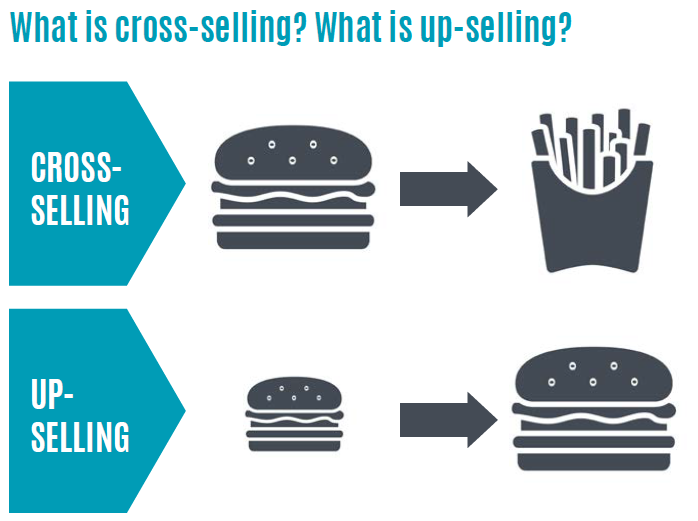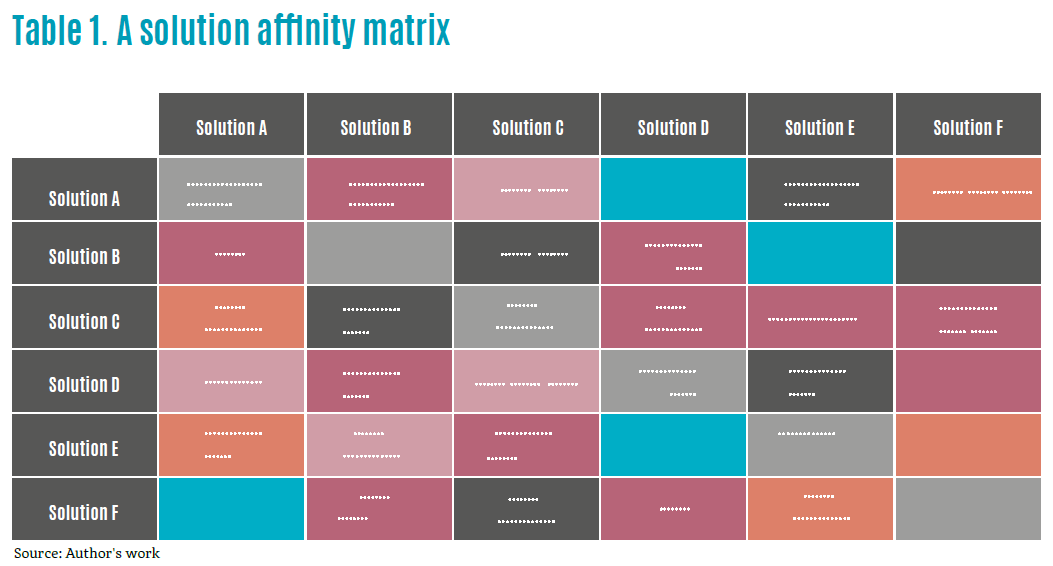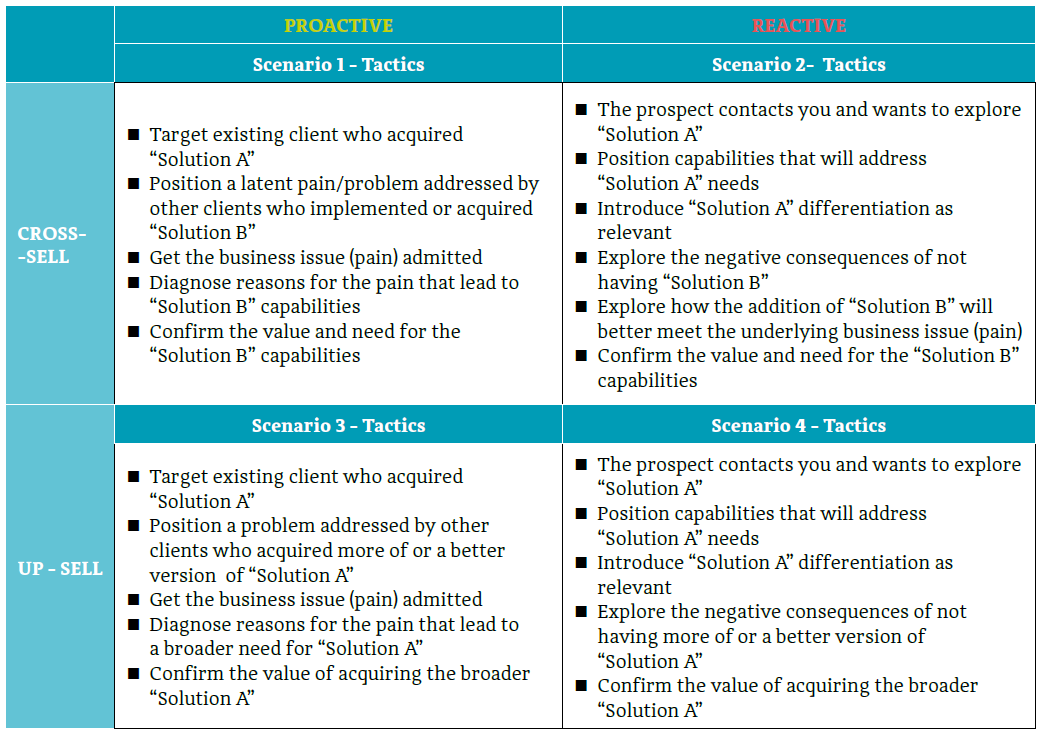How to cross-sell effectively
Experienced sales professionals know that it’s generally easier and faster to sell to current customers who know your company’s brand than to new customers who do not. ‘You’re 60-70% likely to sell to an existing customer, compared to the 5-20% likelihood of selling to a new prospect,’ reported Hubspot.1

Yet only one out of every 20 companies rate themselves as exceptional cross-sellers to their current customers, according to recent research by CSO Insights.2 Since acquiring a new customer is anywhere from five to 25 times more expensive than retaining an existing one, according to the Harvard Business Review3, why do so many sales teams fail to master cross-selling and up-selling to their existing base of customers?
In working with hundreds of clients, we observe that virtually all companies train their salespeople extensively on how to pursue and close new business, but relatively few provide training on how to cross-sell to existing clients. Many managers assume that the same sales approaches and methods apply in either scenario, but this is not accurate. Successful cross-selling and up-selling require specific disciplines and techniques.
What is cross-selling and up-selling?
Repeat buying differs from cross-selling and up-selling because it is driven largely by customer experience and satisfaction. If a customer perceives good value from a purchased product or service, they are more likely to remain loyal to that brand and buy it again in the future.
Unlike repeat buying, cross-selling and up-selling are both focused on selling new things to an existing customer – either a new product or service, or an improved or larger solution than their initial purchase. A positive experience with an initial purchase is still important to successful cross-selling and up-selling, as this influences a buyer’s perception of your value as a solution provider in general. To succeed in cross-selling and up-selling, a salesperson must be able to leverage the trust and credibility generated by the buyer’s initial positive experience.
Cross-selling, then, is simply enhancing the value previously received by a customer by introducing complementary solutions. Up-selling is enhancing the value previously received by a customer by providing expanded, improved or larger options for the same solution.
An often cited and simple example of cross-selling is a fast food restaurant, where a host asks a patron if they’d like fries with their hamburger. That host may also up-sell a customer by asking if she would like those fries to be a large size instead of medium.
The solution affinity matrix
One simple exercise that can help sales professionals in their cross-selling and up-selling efforts is constructing a solution affinity matrix (Table 1). The question this helps to answer is: if a customer has previously purchased solution X, how could the value of this be enhanced by also purchasing solution Y? By listing all the potential solutions and cross-referencing this list against itself, a seller can then identify the most likely cross-selling opportunities and formulate reasons that a buyer should consider for such a purchase.
In addition, where the affinity matrix cross-references the same solution, a seller can consider options for up-selling larger or enhanced versions of that solution, and list reasons for doing so.
Not all cross-references of solutions will produce logical reasons for cross-selling or up-selling, and this is natural – not all products or services have a logical affinity with each other. But for those solution linkages that do, the affinity matrix can be a powerful tool for sellers, as it shows how they can position the value of cross-selling and up-selling options for buyers.
We find that salespeople rarely consider more than one or two obvious solution affinities and are often surprised by the number of actual cross-selling and up-selling opportunities available in their portfolio of offerings, once they take the time to examine them. By compiling a solution affinity matrix, the full potential of new sales to existing customers is fully revealed.
Effective cross-selling puts value enhancement first
With a solution affinity matrix in hand, a salesperson can then evaluate existing customers’ previous purchases, and identify opportunities for enhancing or expanding the value of those purchases through cross-selling and up-selling.
All too often, we see organizations try to enhance the sales of a particular product with special incentives or sales awards. While these can have some positive effect, incentives alone are not enough to drive cross-selling or up-selling success. Sellers also need to know how to position the value of a cross-sell or up-sell to a customer, and what to say when they engage with them.
It is much easier for sellers to approach a current customer with ‘I see a way we can improve the value you are already getting from our product Y’ than to say ‘I’m glad you bought Y from us – would you also like to buy our product Z?’ The latter is simply a sales pitch – the former is being of service by pointing out an opportunity, which is probably not yet known to the buyer.
This value-focused style also helps buyers perceive sellers as proactive consultants, rather than simply product-pushing salespeople. If sellers can articulate clear reasons for a cross-selling offer, and describe its potential value to the buyer, then the customer is more likely to perceive the offer to be in their interest.
Cross-selling conversations
What is the best way to engage with customers for cross-selling or up-selling opportunities? This depends on the nature of the engagement. Is the seller reaching out to a customer to offer a cross-selling idea? Or is the seller engaging with a buyer who has come to them? Depending on the context of the buyer-seller engagement, the cross-selling conversation could go a couple of different ways.
If the seller is approaching a customer with a cross-selling or up-selling idea, their goal should be to first diagnose their situation and verify that a potential solution with high affinity to a previous purchase will provide enough value to encourage the buyer to take action. This type of sales conversation focuses on creating a clear vision in the mind of the buyer on how the cross-sold or up-sold capabilities create incremental value.
If a customer approaches the seller, then the seller’s goal should be to make their offered solution equal to existing needs before introducing differentiating options. This type of sales conversation focuses on enhancing or re-engineering the buyer’s current vision, providing a basis for introducing new or expanded capabilities.
The tactics used for effective cross-selling and up-selling conversations vary slightly, depending on the context of the buyer-seller engagement, but these variances are critically important to achieving successful outcomes consistently – for both the seller and the buyer.
Cross-selling success
One of our clients operates retail stores for the rental of construction equipment and related supplies. Their sales staff in each location were not cross-selling or up-selling very effectively. Instead, most were simply taking the orders of customers who came into their location.
When we visited several store locations and interviewed the sales staff, we asked them why they did not try to sell more of their organization’s products and services to visiting customers. Most answered that they were simply not comfortable with disrupting customers’ ideas of what they wanted to buy. They were afraid of being perceived as ‘too pushy’ or ‘too aggressive’, and thereby drive those customers to other competitors.
Another reason that some sales staff admitted, somewhat reluctantly, was that they were not fully knowledgeable about all of the products they had available. They did not believe they could position the value of such offerings effectively.
After developing a solution affinity matrix, and training the sales staff on the most likely cross-selling and up-selling opportunities, this client saw the average transaction sizes grow by double-digit percentages in each location. Once the sales team knew how to engage with customers in a way that was perceived as truly valuable and useful, they were more comfortable in providing cross-selling and up-selling options.
This example illustrates the three most important lessons to be learned for successful cross-selling and up-selling:
- Knowledge creates confidence. If a salesperson knows how a cross-selling and up-selling option creates value for a customer, they are much more willing and able to have a successful sales conversation with that buyer.
- You have more cross-selling and up-selling opportunities than you think. Construct a solution affinity matrix for your own portfolio of offerings and identify the most likely cross-selling and up-selling solution linkages, and the reasons for buying them. The insights that this exercise provides can literally turn into gold for your sales team.
- Align your cross-selling and up-selling style to how you engage with each buyer. Training your sales staff for proactive and reactive sales interactions for both cross-selling and up-selling opportunities can make a huge difference in the consistency and quantity of sales results.
Przypisy / Źródła
References:
- Retrieved April 25,2019 from https://blog.hubspot.com/service/cross-selling
- Retrieved April 24,2019 from https://www.csoinsights.com/wp-content/uploads/sites/5/2018/06/2016-SPO-Keep-and-Grow-More-Analysis.pdf
- Retrieved April 29,2019 from https://hbr.org/2014/10/the-value-of-keeping-the-right-customers

















